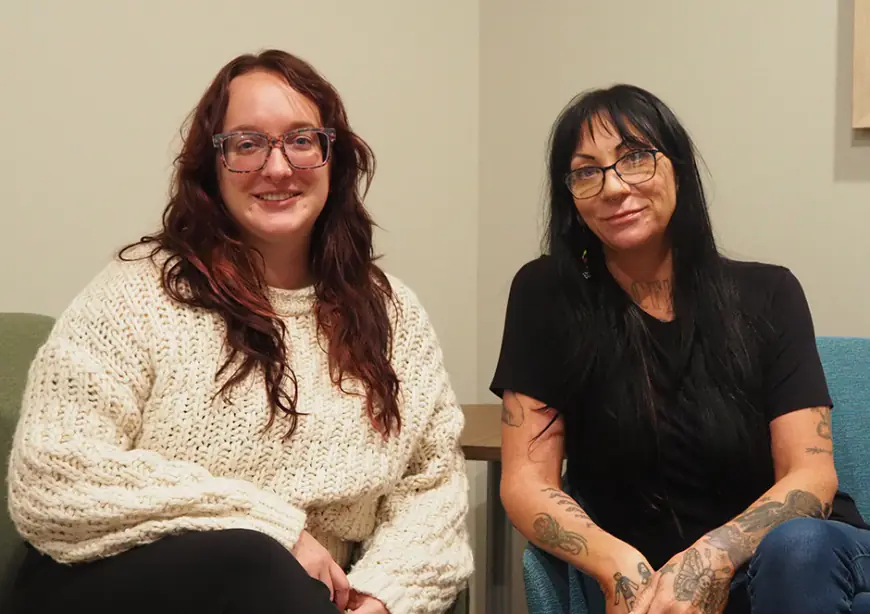Emma Norton ‘living room’ option provides crisis help in a relaxed environment
Program at St. Paul facility offers an alternative to mental health care in busy ERs that can often heighten symptoms. The post Emma Norton ‘living room’ option provides crisis help in a relaxed environment appeared first on MinnPost.


A person in the midst of a mental health crisis can feel overwhelmed, frightened and confused. Too often, people in these situations end up in the emergency room — a bright, loud, impersonal space that can only exacerbate their symptoms.
Earlier this summer, The Living Room, a new option for people in mental health crisis, opened at the Emma Norton Residence, a permanent residential housing facility for people who are homeless or at-risk of becoming homeless and managing mental illness and/or chemical dependency, in St. Paul’s Highland Bridge development.
The Emma Norton Living Room, a quiet, welcoming walk-in option with a fireplace, a couch and a few easy chairs, is staffed by a team of specially trained certified peer support specialists. Modeled after similar programs in Illinois, the Emma Norton program is designed to offer a low-barrier option for adults over 18 in need of mental health support, a place they can come and talk to others who have been through similar life situations and learn about options for more immediate or longer-term help.
Lauren Daniel, Emma Norton clinical director, explained that the program’s homey feel is intentional. The driving concept behind Living Room programs is to create a space that will make visitors feel comfortable and at ease — the opposite of a busy hospital ER.
“It’s a really cozy, warm room where you can get that one-on-one individual support in a way that’s nonjudgmental,” Daniel said. Clients come from across the mental health continuum. “Maybe you’re experiencing your first panic attack and you don’t recognize those symptoms and you want to talk to someone about it,” she said. “Or maybe it’s folks who are feeling suicidal and they’ve got a plan that they don’t really want to act on so they’re looking for guidance, deescalation and connection to mental health resources.”
Living Room programs are designed to welcome all comers, Daniel added: “Any and all are welcome in the space. That’s the really cool thing about the model.” No insurance or appointments are required, and the program is open seven days a week from 12 p.m.-8 p.m. Startup costs for the Emma Norton Living Room were funded by a $200,000 grant from the Medica Foundation combined with grants from the Minnesota Department of Human Services and Ramsey County.
Jacki Yellowflower, Emma Norton peer specialist supervisor, said the program’s low-barrier approach is especially appealing to participants. “It’s really mellow,” Yellowflower said. “People just come in. We have to get certain information from them for our grant purposes, but it’s really simple and fast. Then we just have a conversation.”
Those initial conversations, Yellowflower said, are focused on learning more about the issues that brought the individual to the space. “We just help them figure out what the crisis is. For many people, the word ‘crisis’ is intimidating, like, ‘What I’m feeling, does that constitute a crisis?’” she said. “But it could be pretty much anything that’s bothering them that they want to talk about.”

Living Room staff know how to support people experiencing a range of mental health issues, Yellowflower said. “We have experience with people in active psychosis, the whole spectrum. We’re welcoming,” she said.
Once staff is able to determine the client’s needs, they focus on providing support and connecting them with outside resources. “Basically, our role is deescalation, figuring out what the situation is,” Yellowflower said. “The drop-in thing makes us more accessible, and our hours make us more available than regular clinics. We are the only peer-led drop-in crisis center in Minnesota.”
Before opening the Emma Norton Living Room, Daniel, Yellowflower and Shawna Nelsen-Wills, Emma Norton advancement director, drove to suburban Chicago to visit a Living Room Program there. The Chicago Metro Suburban chapter of NAMI has been a major advocate for Living Room programs in Illinois, Nelsen-Wills said. They wanted to learn more about how staffers run the program.
In Illinois, Nelsen-Wills said, organizers “were able to show such success that they went to their state legislature, and now Living Room programs in the state are fully funded 24-7. We’re hopeful that we’ll be able to show the same kind of success here and eventually get additional public funding here.”
Though Emma Norton’s Living Room program has only been officially open for a few weeks and has not gotten a lot of publicity, it is still getting a steady stream of visitors. Since the program’s soft opening in August, Nelsen-Wills said “we’ve had 38 visits so far.”
A safe place for women
The Emma Norton Residence was founded in 1917 in St. Paul as a safe place where women coming from rural areas of the state could live in the capital city.
“Back then, women couldn’t come to live in the city unescorted, say if they weren’t married or didn’t have an uncle to stay with,” Nelsen-Wills said. “They couldn’t rent their own apartment.” The residence, originally located near St. Paul’s Summit Avenue and then later moved to Robert Street in downtown St. Paul, was, she said, “a home for girls where you would be able to go to school or work and access opportunities beyond getting married.” The Robert Street building was designed like a dorm, with single rooms with no kitchens. “They served three meals a day,” she said.
By the 1970s, more options were available to single women, and fewer needed to live in places like Emma Norton. As the city’s unhoused population grew, Ramsey County eventually asked Emma Norton leaders if the program could become a shelter for women experiencing homelessness.
In this new configuration, it didn’t take long for Emma Norton staff to realize that residents needed much more than physical shelter. “We were seeing a lot of mental health or chemical dependency or domestic violence or other issues,” Nelsen-Wills said. In response, she explained, “We quickly became more supportive of housing.”
This new approach didn’t work well with the existing building, which had little space beyond resident rooms, shared bathrooms, a kitchen and a dining room, Nelsen-Wills said. There was no office space for the growing number of staff members needed to run the program. And the building, which had been rebuilt in the 1960s, was showing its age.
“We were putting so much money into maintenance,” Nelsen-Wills said. Instead, “We wanted to put our money into staff and into our clients and our programs.” Program leaders decided to focus on building a new location that would better serve everyone.
A few years ago, Emma Norton leadership teamed with Minneapolis-based nonprofit housing developer Project for Pride in Living to gather funding for a new building. The program ended up in the new Highland Bridge development after PPL was chosen as one of its nonprofit development partners. Eventually, the project was funded through Minnesota Housing’s super RFP process to the tune of $18 million.
Because the facility was built new from the ground up, Nelsen-Wills said, Emma Norton leadership had the opportunity to collaborate on its design.
“We knew we wanted everybody to have their own apartment. We knew we wanted to have programming spaces. So each floor has a programming space,” she said. “There’s an art room. There’s a gardening room. There’s a community kitchen. There’s arts spaces. There’s a children’s play space.” In compliance with fair-housing laws, the program, which still predominantly serves women, now also welcomes men and people of all gender identities.
To cover outstanding costs, including furniture and housing supplies for residents, Emma Norton launched its own capital campaign with a goal of raising $3.75 million. “We’ve raised $3.4 million to date,” Nelsen-Wills said. “When people moved in, everyone had a bed and furniture. We didn’t want to take people from homelessness, give them a beautiful apartment and then say they have to sleep on the floor.”
The power of peer support
To many, the most important element of the Living Room model of mental health is the bulk of its services being offered by peer support specialists rather than medical professionals. With their personal history of mental illness and addiction, peers often feel more relatable to people in crisis, and their approach to the work is significantly different than the more distant “professional” approach preferred by credentialed professionals like psychologists and social workers.
“A lot of times when you are meeting with your therapist or a social worker, they are trained to not share personal information,” Daniel said. “But what I love about peer support is that that barrier is not there. It is a job requirement that they share their personal experiences. Anytime our peer support staff share a personal story in a meeting that I’ve been a part of, it’s just so powerful and it gives a different perspective on things.”
Yellowflower said she often shares her personal history in her work with clients.
“I’ve been with Emma Norton for about 10 years,” she said. She explained that she lived in the program for two years, then left for a bit before coming back to join the program’s staff. “I experienced the criminal justice system, chaotic family violence, drug addiction, alcohol addiction and things like that,” she said. “And it’s not just me; a lot of our peer supports have personal experience in a variety of different areas. That makes us a little bit more relatable.”
Daniel said that she understands why many Living Room clients prefer to speak with a peer. “I’ve noticed clients have a hesitancy in meeting with me because I’ve got letters behind my name. There’s a stigma that comes with being a social worker — especially when folks have trauma histories that involve the criminal justice system. It makes it harder to open up,” she said.
Yellowflower understands that hesitancy all too well. “It does make it harder to relate to a provider because that’s your experience,” she said. “If you’re labeled an addict, you’re pre-judged. It makes you not want to open up.”
In recognition of that fact, peers run The Living Room program, Nelsen-Wills said, with professionally credentialed mental health staff like Daniel on duty to for backup if a client needs to be transferred to a hospital.
So far, Daniel said, her assistance hasn’t been needed. The peer support staff have things under control. “We’ve been open since Aug. 5 and I’ve gotten one on-call phone call so far,” she said. “I can’t speak highly enough of how proud I am of our peer support team and the hard work that they’ve been putting in.”
At the Emma Norton Residence Living Room program, two peer support specialists are always on duty. So far, that has been enough to meet client needs, but if the program begins to attract more people, Nelsen-Wills said they will staff up.
“If we start to have a bunch of people waiting to talk to someone,” she said, “that is an opportunity for me to say we’ve got this issue and we need more funding so we can bring more people on.”

Andy Steiner
Andy Steiner is a Twin Cities-based writer and editor. Before becoming a full-time freelancer, she worked as senior editor at Utne Reader and editor of the Minnesota Women’s Press. Email her at asteiner@minnpost.com.
The post Emma Norton ‘living room’ option provides crisis help in a relaxed environment appeared first on MinnPost.
What's Your Reaction?









































































































